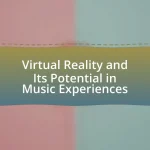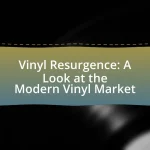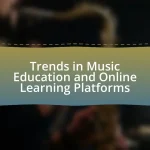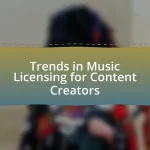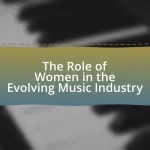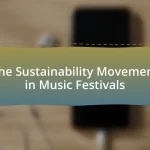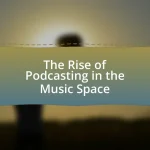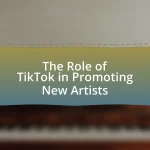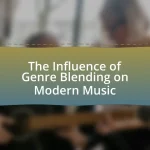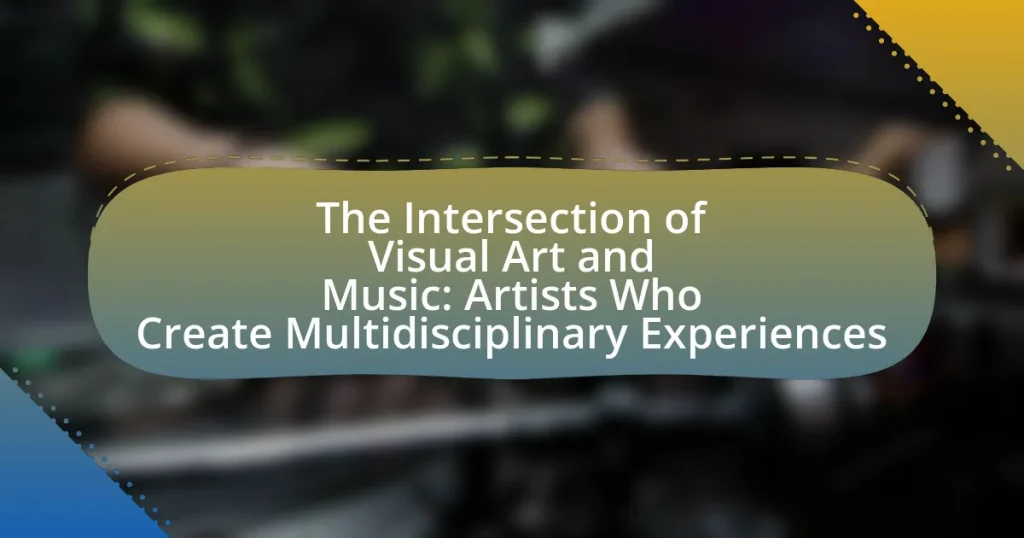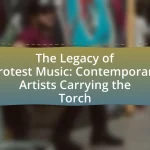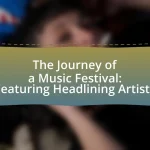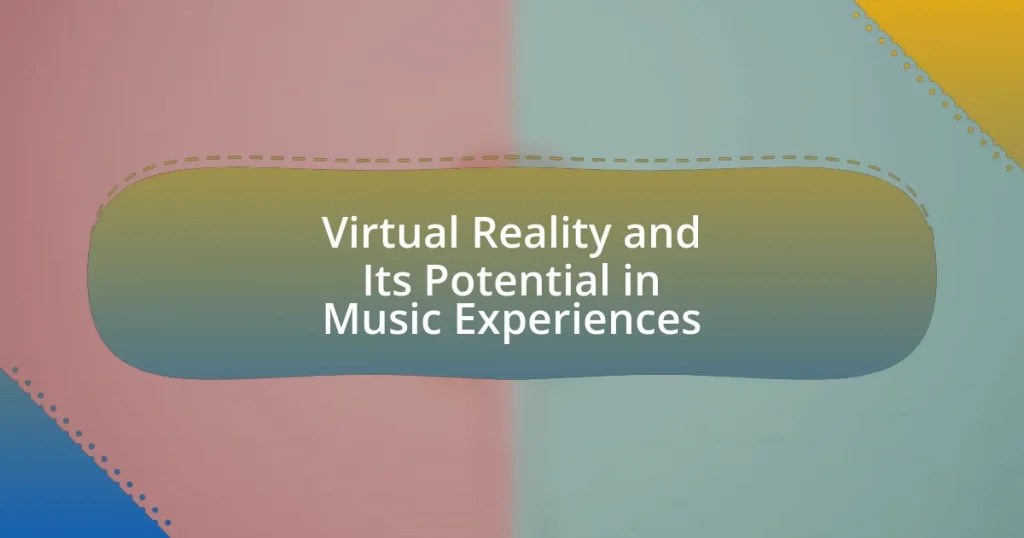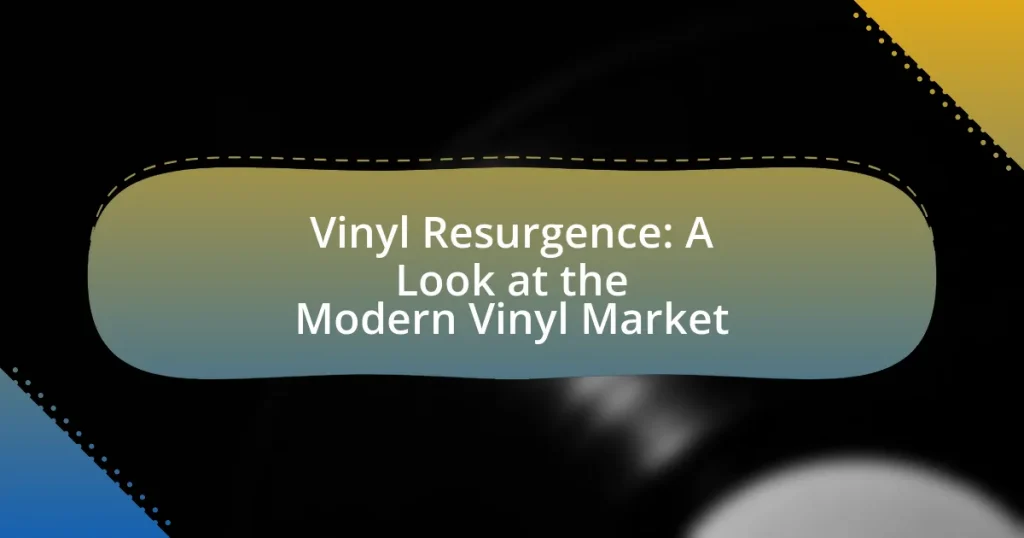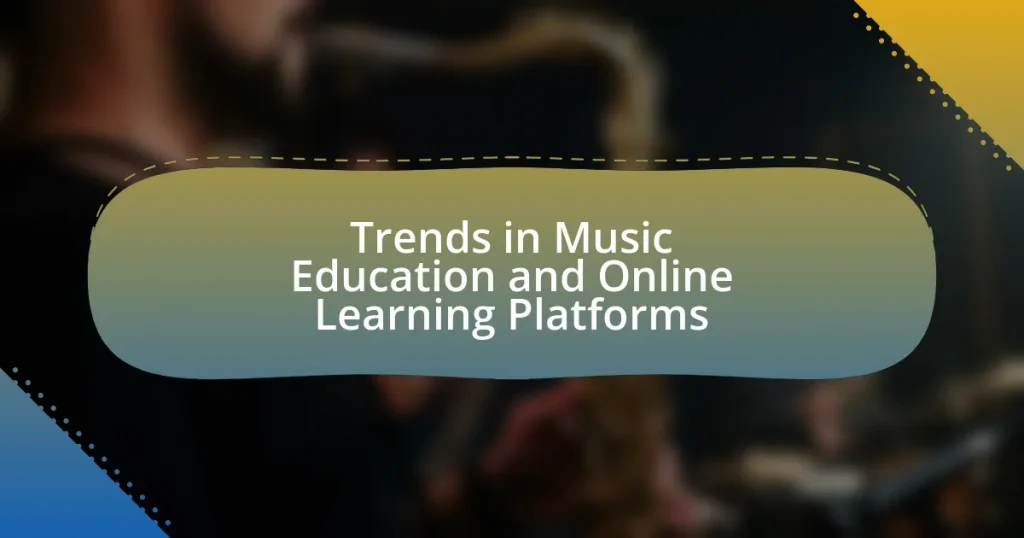The article focuses on the intersection of visual art and music, highlighting how these two creative forms combine to create multidisciplinary experiences. It explores historical connections, cultural perceptions, and the significance of collaboration between artists in enhancing emotional expression and audience engagement. Key artists such as Olafur Eliasson and Brian Eno are discussed for their innovative integration of visual and auditory elements, while current trends and technological influences are examined. The article also addresses challenges faced by artists in this field and offers practical tips for effective collaboration and integration of these art forms.
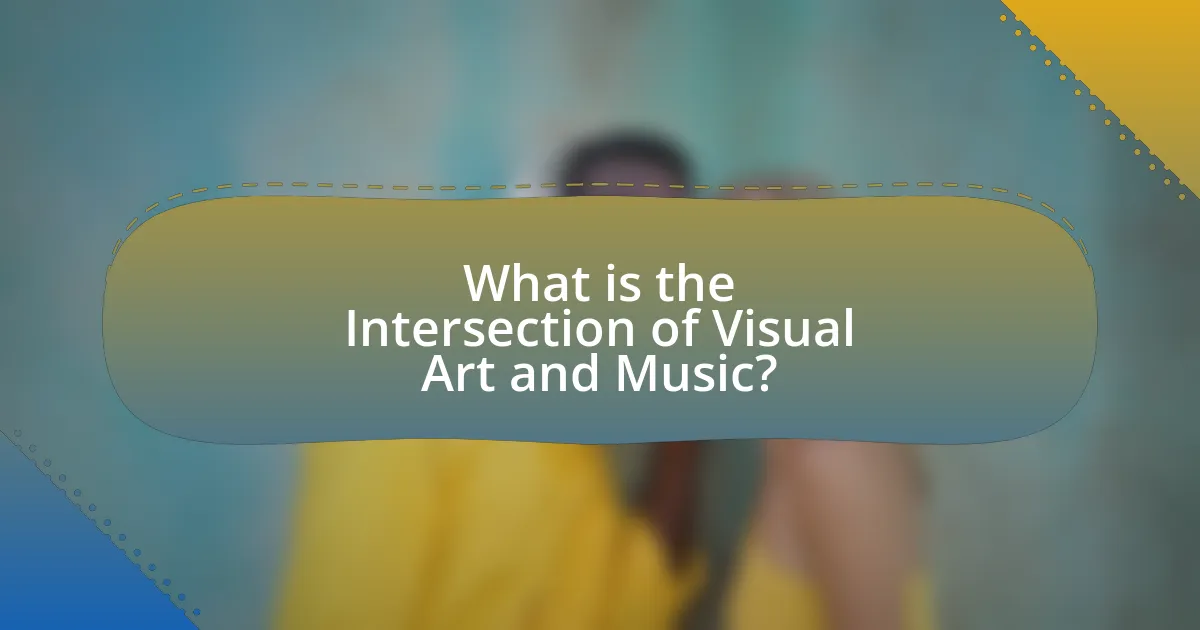
What is the Intersection of Visual Art and Music?
The intersection of visual art and music occurs when these two forms of creative expression combine to enhance the experience of each other, often resulting in multidisciplinary works. This relationship can be seen in various art movements, such as synesthesia, where artists like Wassily Kandinsky and composers like Arnold Schoenberg explored the blending of visual and auditory experiences. Additionally, contemporary artists often create installations that incorporate sound elements, such as Olafur Eliasson, who integrates music into his visual art to evoke emotional responses. This synergy not only enriches the audience’s engagement but also expands the boundaries of both disciplines, demonstrating how visual art and music can coexist and complement one another.
How do visual art and music complement each other?
Visual art and music complement each other by enhancing emotional expression and creating immersive experiences. The combination of visual elements, such as colors and shapes, with auditory components, like rhythm and melody, can evoke deeper emotional responses in audiences. For instance, synesthetic experiences, where individuals perceive music as colors or shapes, illustrate how these two art forms can intertwine to create a richer sensory experience. Historical examples include multimedia performances by artists like Wassily Kandinsky, who believed in the spiritual connection between visual art and music, and contemporary installations that combine projections with soundscapes, demonstrating their synergistic potential.
What are the historical connections between visual art and music?
Visual art and music have historically influenced each other through shared cultural movements and collaborative practices. For instance, during the Renaissance, artists like Leonardo da Vinci and composers such as Giovanni Gabrieli explored the relationship between visual composition and musical harmony, emphasizing balance and proportion in both fields. In the 20th century, movements like Surrealism and Abstract Expressionism saw artists such as Wassily Kandinsky advocate for the synesthetic experience, where visual art was intended to evoke musical sensations. Additionally, multimedia performances, such as those by artists like John Cage, integrated visual elements with music, further blurring the lines between the two disciplines. These historical connections illustrate a continuous dialogue that has shaped both visual art and music throughout time.
How do different cultures perceive the relationship between visual art and music?
Different cultures perceive the relationship between visual art and music as interconnected forms of expression that enhance emotional and sensory experiences. For instance, in African cultures, music and visual art often coexist in rituals and celebrations, where vibrant colors and rhythmic sounds work together to convey spiritual narratives. In contrast, Western cultures have historically viewed visual art and music as distinct disciplines, although movements like the Gesamtkunstwerk in the 19th century sought to unify them, exemplified by Richard Wagner’s operas that integrated visual staging with musical composition. Additionally, in Eastern traditions, such as in Japan, the concept of “mono no aware” emphasizes the beauty of transience, where both visual art and music reflect the ephemeral nature of life, creating a harmonious relationship that resonates deeply with cultural values. These examples illustrate that the perception of the relationship between visual art and music varies significantly across cultures, shaped by historical, social, and spiritual contexts.
Why is the multidisciplinary approach significant?
The multidisciplinary approach is significant because it fosters innovation by integrating diverse perspectives and methodologies from various fields. This integration allows artists to create richer, more complex experiences that engage audiences on multiple sensory levels. For instance, artists who combine visual art and music can evoke emotional responses that are deeper than what either medium could achieve alone, as evidenced by the works of artists like Olafur Eliasson and Brian Eno, who utilize elements from both disciplines to enhance viewer engagement and interaction. This collaborative synergy not only broadens the scope of artistic expression but also encourages cross-disciplinary dialogue, ultimately leading to new forms of creativity and understanding in the arts.
What are the benefits of combining visual art and music?
Combining visual art and music enhances sensory experiences and fosters emotional connections. This integration allows individuals to engage multiple senses simultaneously, leading to a more immersive experience. Research indicates that multisensory experiences can improve memory retention and emotional responses, as evidenced by studies showing that participants recall information better when it is presented through both visual and auditory stimuli. Additionally, the collaboration between visual artists and musicians can inspire creativity and innovation, as seen in various art installations and performances that blend these two forms of expression, ultimately enriching cultural experiences and broadening artistic horizons.
How does this approach enhance audience engagement?
This approach enhances audience engagement by creating immersive experiences that stimulate multiple senses simultaneously. Artists who blend visual art and music can evoke emotional responses more effectively, as studies indicate that multisensory experiences can increase retention and enjoyment. For instance, research published in the journal “Psychological Science” shows that engaging multiple senses can lead to a 50% increase in memory recall. By integrating visual elements with musical compositions, artists foster a deeper connection with their audience, encouraging active participation and emotional investment in the experience.
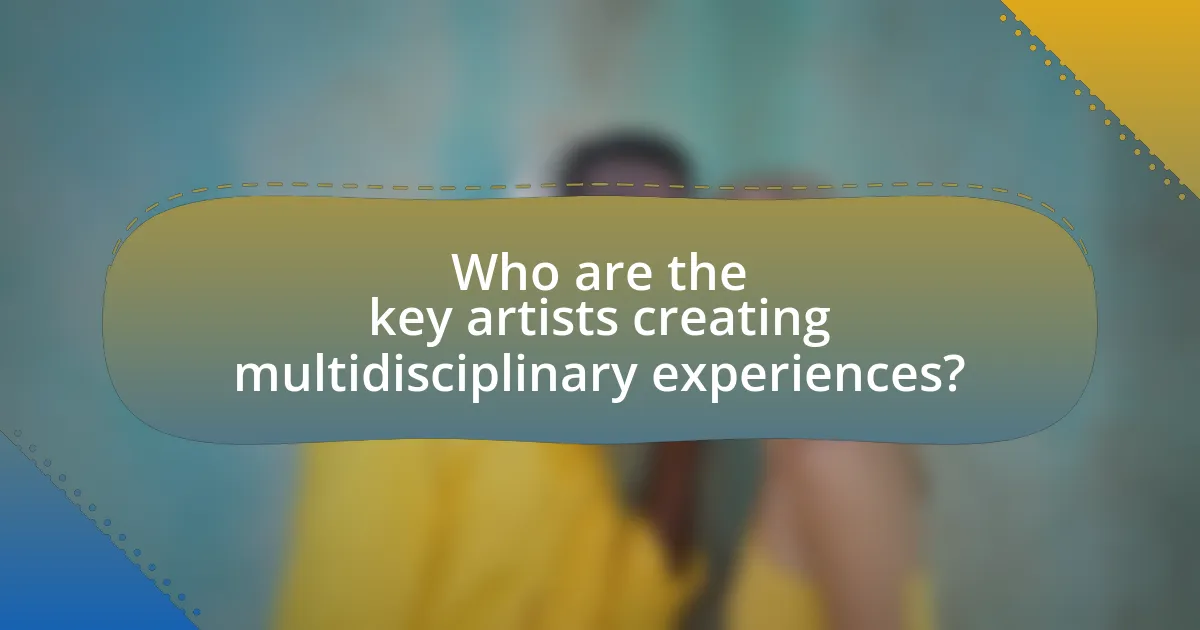
Who are the key artists creating multidisciplinary experiences?
Key artists creating multidisciplinary experiences include Olafur Eliasson, who integrates light and environmental elements into immersive installations, and Marina Abramović, known for her performance art that often combines visual art with audience interaction. Additionally, artists like Ryoji Ikeda fuse sound and visual art through data-driven installations, while teamLab creates interactive digital art that merges technology with traditional aesthetics. These artists exemplify the blending of various mediums to create holistic experiences that engage multiple senses.
What are some notable examples of artists in this field?
Notable examples of artists who create multidisciplinary experiences at the intersection of visual art and music include Olafur Eliasson, who integrates light and sound in immersive installations, and Brian Eno, known for his ambient music that often incorporates visual elements. Additionally, artists like Marina Abramović have combined performance art with musical components, creating profound sensory experiences. These artists exemplify the blending of visual and auditory art forms, enhancing audience engagement through their innovative approaches.
How do these artists integrate visual art and music in their work?
Artists integrate visual art and music by creating immersive experiences that combine auditory and visual elements, often using multimedia installations. For example, artists like Olafur Eliasson and Brian Eno have developed works where light, color, and sound interact to evoke emotional responses, demonstrating the synergy between these two forms of expression. Eliasson’s installations often incorporate soundscapes that enhance the visual experience, while Eno’s ambient music is designed to complement visual art, creating a cohesive atmosphere that engages multiple senses. This integration not only enriches the audience’s experience but also expands the boundaries of both disciplines, allowing for innovative forms of artistic expression.
What techniques do they use to create immersive experiences?
Artists create immersive experiences by employing techniques such as interactive installations, multimedia projections, and spatial audio. Interactive installations engage audiences by allowing them to participate actively, enhancing their emotional connection to the artwork. Multimedia projections combine visual art with music, creating a cohesive sensory experience that captivates viewers. Spatial audio techniques enhance the auditory experience by using sound placement and movement, making the audience feel enveloped in the environment. These methods have been validated by numerous exhibitions, such as teamLab’s immersive art installations, which have attracted millions of visitors and demonstrated the effectiveness of combining visual and auditory elements to create engaging experiences.
What influences these artists’ creative processes?
Artists’ creative processes are influenced by a combination of personal experiences, cultural contexts, and collaborative interactions. Personal experiences shape their emotional responses and thematic choices, while cultural contexts provide a framework of societal norms and historical references that inform their work. Collaborative interactions with other artists and disciplines, such as music, enhance their creative output by introducing new perspectives and techniques. For instance, artists like Björk and David Bowie have integrated visual art into their music, demonstrating how cross-disciplinary collaboration can lead to innovative artistic expressions.
How do personal experiences shape their multidisciplinary works?
Personal experiences significantly influence multidisciplinary works by providing unique perspectives and emotional depth. Artists often draw from their life events, cultural backgrounds, and personal challenges, which inform their creative choices and thematic explorations. For instance, an artist who has experienced trauma may incorporate elements of that experience into both visual art and music, creating a cohesive narrative that resonates with audiences on multiple levels. This integration of personal history not only enriches the artistic expression but also fosters a deeper connection with viewers and listeners, as evidenced by the works of artists like Björk, who blends her Icelandic heritage and personal experiences into her music and visual presentations.
What role does collaboration play in their artistic endeavors?
Collaboration plays a crucial role in the artistic endeavors of multidisciplinary artists by enhancing creativity and expanding the scope of their work. When visual artists and musicians collaborate, they combine their unique perspectives and skills, resulting in innovative experiences that transcend traditional boundaries. For instance, artists like Olafur Eliasson and musician Brian Eno have successfully merged visual art with sound, creating immersive installations that engage audiences on multiple sensory levels. This synergy not only enriches the artistic output but also fosters a dialogue between different art forms, leading to new interpretations and experiences.
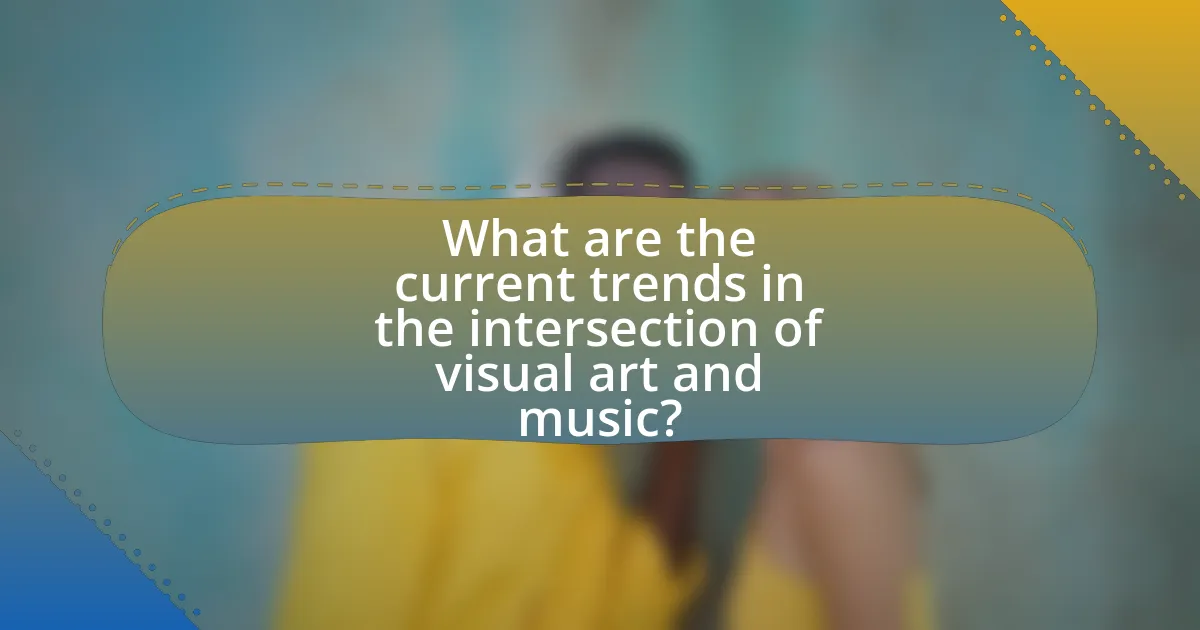
What are the current trends in the intersection of visual art and music?
Current trends in the intersection of visual art and music include immersive installations, live visual performances, and the integration of technology such as augmented reality and virtual reality. Immersive installations, like those created by teamLab, combine visual art and music to create environments where audiences can engage with both mediums simultaneously. Live visual performances, often seen in concerts, utilize visual projections that respond to the music in real-time, enhancing the overall experience. Additionally, the use of technology allows artists to create interactive experiences, where viewers can influence the visual and auditory elements, exemplified by projects like “The Infinite Room” by Yayoi Kusama, which merges sound and visual art in a captivating way. These trends reflect a growing desire for multidisciplinary experiences that engage audiences on multiple sensory levels.
How is technology influencing multidisciplinary art forms?
Technology is significantly influencing multidisciplinary art forms by enabling innovative collaborations between visual art and music. Digital tools such as software for graphic design, video editing, and sound engineering allow artists to merge different mediums seamlessly, creating immersive experiences. For instance, artists like Refik Anadol utilize artificial intelligence to generate visualizations that respond to music, enhancing the sensory experience for audiences. Additionally, platforms like Adobe Creative Cloud provide artists with the resources to experiment and push the boundaries of traditional art forms, leading to new genres that blend visual and auditory elements. This integration of technology not only expands creative possibilities but also democratizes access to artistic tools, allowing a broader range of artists to participate in multidisciplinary projects.
What are the emerging tools and platforms for artists?
Emerging tools and platforms for artists include digital art software like Procreate and Adobe Fresco, as well as collaborative platforms such as ArtStation and Behance. These tools enable artists to create, showcase, and sell their work in innovative ways. For instance, Procreate offers advanced features for digital painting, while ArtStation provides a community for artists to connect and share their portfolios, enhancing visibility and opportunities for collaboration. Additionally, platforms like SoundCloud and Bandcamp are gaining traction among musicians, allowing them to distribute their music directly to audiences, which complements visual art in multidisciplinary projects.
How do these technologies change the way audiences experience art and music?
Technologies such as virtual reality, augmented reality, and interactive installations significantly enhance how audiences experience art and music by creating immersive environments that engage multiple senses. These technologies allow audiences to interact with art and music in real-time, fostering a deeper emotional connection and personal interpretation. For instance, virtual reality experiences can transport users into a 3D space where they can explore artworks or musical compositions from various perspectives, as demonstrated by projects like “The Night Cafe,” which immerses users in a digital recreation of Vincent van Gogh’s famous painting. Additionally, augmented reality applications can overlay digital elements onto physical artworks, enriching the viewing experience with contextual information or interactive features, as seen in initiatives like the “Artivive” platform. This shift from passive observation to active participation transforms the traditional boundaries of art and music, making the experience more engaging and personalized.
What are the challenges faced by artists in this field?
Artists in the field of multidisciplinary experiences, particularly at the intersection of visual art and music, face several challenges, including funding, audience engagement, and collaboration. Funding is often limited, as projects that blend multiple disciplines may not fit neatly into traditional grant categories, making it difficult for artists to secure financial support. Audience engagement poses another challenge, as artists must find ways to attract and maintain interest from diverse audiences who may have varying levels of appreciation for either visual art or music. Additionally, collaboration can be complex, as artists from different backgrounds may have differing creative visions, communication styles, and working processes, which can lead to conflicts or misunderstandings. These challenges are supported by studies indicating that artists often report financial instability and difficulties in reaching audiences effectively in multidisciplinary projects.
How do funding and resources impact multidisciplinary projects?
Funding and resources significantly influence multidisciplinary projects by determining the scope, quality, and sustainability of the initiatives. Adequate funding allows for the hiring of diverse talent, access to advanced technology, and the ability to secure venues for exhibitions or performances, which are crucial for the successful integration of visual art and music. For instance, a study by the National Endowment for the Arts found that projects with higher funding levels are more likely to achieve their artistic goals and reach broader audiences. Additionally, resources such as materials, equipment, and collaborative networks enhance the creative process, enabling artists to experiment and innovate across disciplines. Therefore, the availability of funding and resources directly correlates with the potential impact and success of multidisciplinary projects.
What barriers exist in the collaboration between visual artists and musicians?
Barriers in the collaboration between visual artists and musicians include differences in creative processes, communication challenges, and varying professional expectations. Visual artists often focus on static imagery and spatial composition, while musicians prioritize temporal elements and auditory experiences, leading to potential misunderstandings in collaborative projects. Additionally, the lack of a common language to express artistic ideas can hinder effective communication, resulting in misaligned visions. Furthermore, differing expectations regarding project timelines, financial compensation, and the distribution of creative credit can create friction, making collaboration difficult. These barriers are supported by studies indicating that interdisciplinary collaborations often face challenges due to these fundamental differences in artistic practice and professional norms.
What practical tips can artists consider when creating multidisciplinary experiences?
Artists creating multidisciplinary experiences should prioritize collaboration across different art forms to enhance creativity and innovation. Engaging with musicians, dancers, and visual artists can lead to unique synergies that enrich the overall experience. Additionally, artists should consider the audience’s perspective by designing interactive elements that invite participation, fostering a deeper connection with the work. Utilizing technology, such as projection mapping or sound installations, can also elevate the experience by merging visual and auditory elements seamlessly. Research indicates that interdisciplinary collaboration can lead to more impactful art, as seen in projects like “The Creators Project,” which showcases the fusion of art and technology.
How can artists effectively collaborate across disciplines?
Artists can effectively collaborate across disciplines by establishing clear communication, setting shared goals, and integrating their unique skills to create cohesive works. Clear communication ensures that all parties understand each other’s artistic visions and methodologies, which is crucial for successful collaboration. Setting shared goals aligns the artists’ intentions and helps maintain focus throughout the creative process. Integrating unique skills allows artists to leverage their strengths, resulting in innovative and multidisciplinary experiences. For instance, the collaboration between visual artist Olafur Eliasson and musician Brian Eno exemplifies how combining distinct artistic practices can lead to immersive installations that engage audiences on multiple sensory levels.
What strategies can enhance the integration of visual art and music?
Collaborative projects between visual artists and musicians can significantly enhance the integration of visual art and music. These collaborations allow for the creation of immersive experiences where visual elements complement musical compositions, fostering a deeper emotional connection for the audience. For instance, events like multimedia performances or installations, where live music is paired with dynamic visual projections, have been shown to engage viewers more effectively than either medium alone. Research indicates that such interdisciplinary approaches can lead to increased audience retention and satisfaction, as evidenced by studies conducted at institutions like the Massachusetts Institute of Technology, which highlight the positive impact of multisensory experiences on engagement levels.
